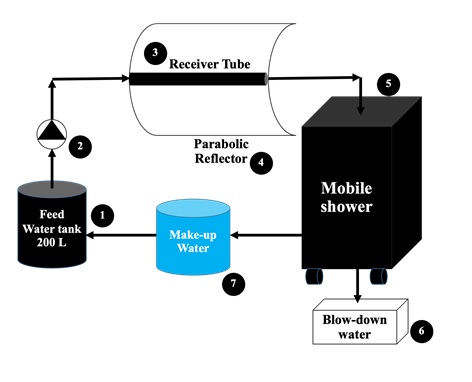การพัฒนาเครื่องต้นแบบตัวเก็บรังสีดวงอาทิตย์แบบรางพาราโบลิกสำหรับผลิตน้ำร้อนใช้ในพื้นที่ชนบทด้วยคอมพิวเตอร์ช่วยในการคำนวณทางวิศวกรรม
Main Article Content
บทคัดย่อ
ปัจจุบันมีการนำเทคโนโลยีตัวเก็บรังสีดวงอาทิตย์แบบรางพาราโบลิกมาใช้ประโยชน์ในการผลิตน้ำร้อนกันอย่างแพร่หลายเนื่องด้วยเทคโนโลยีนี้ช่วยเพิ่มประสิทธิภาพในการทำน้ำร้อนให้เพิ่มขึ้นอย่างมีนัยสำคัญด้วยต้นทุนที่ไม่สูงมากนักเมื่อเปรียบเทียบกับเทคโนโลยีอื่นๆ แต่การออกแบบตัวเก็บรังสีดวงอาทิตย์แบบรางพาราโบลิกให้ได้ประสิทธิภาพการทำความร้อนสูงในราคาที่เข้าถึงและสามารถนำไปใช้ในพื้นที่ชนบทได้นั้นยังมีการพัฒนาไม่มากนัก ประกอบกับเทคโนโลยีคอมพิวเตอร์ช่วยในการคำนวณทางวิศวกรรมมีการพัฒนาเพิ่มขึ้นอย่างต่อเนื่อง ดังนั้นจึงเป็นที่มาของงานวิจัยนี้ที่มุ่งเน้นพัฒนาเครื่องต้นตัวเก็บรังสีดวงอาทิตย์แบบรางพาราโบลิกสำหรับผลิตน้ำร้อนใช้ในชนบทด้วยเทคโนโลยีคอมพิวเตอร์ช่วยในการคำนวณทางวิศวกรรมโดยใช้โปรแกรม SolidWorks ซึ่งช่วยทำนายพฤติกรรมการถ่ายเทความร้อนระหว่างของไหลที่ไหลผ่านท่อตัวเก็บรังสีดวงอาทิตย์กับสิ่งแวดล้อม โดยมีวัตถุประสงค์เพื่อเปรียบเทียบผลของประสิทธิภาพเชิงความร้อนของเครื่องต้นแบบตัวเก็บรังสีดวงอาทิตย์แบบรางพาราโบลิกที่ได้จากการจำลองกับการทดลอง และเพื่อศึกษาความคุ้มค่าทางเศรษฐศาสตร์ของเครื่องต้นแบบตัวเก็บรังสีดวงอาทิตย์แบบรางพาราโบลิก ในการทดลองทีมผู้วิจัยดำเนินการทดลอง ตั้งแต่ 8.00 – 17.00 น. ช่วงเดือนเมษายน พ.ศ. 2565 และทำการเก็บการผลตัวแปรต่างๆ ได้แก่ อุณหภูมิน้ำเข้าท่อตัวเก็บรังสีดวงอาทิตย์ อุณหภูมิน้ำออกท่อตัวเก็บรังสีดวงอาทิตย์ อุณหภูมิของอากาศ และความเข้มรังสีดวงอาทิตย์ จากการเปรียบเทียบผลการจำลองกับผลการทดลองที่ได้มีความสอดคล้องกัน นั่นคือ ตัวเก็บรังสีดวงอาทิตย์แบบรางพาราโบลิกสามารถทำน้ำร้อนให้ได้อุณหภูมิสูงถึง 64.3 C (ผลการจำลอง) และ 65 C (ผลการทดลอง) ส่วนประสิทธิภาพเชิงความร้อนอยู่ระหว่าง 26.18 – 68.77% (ผลการจำลอง) และ 27.38 – 69.97% (ผลการทดลอง) ในระหว่างช่วงเวลา 12.00 – 15.00 น.
Article Details

อนุญาตภายใต้เงื่อนไข Creative Commons Attribution-NonCommercial-NoDerivatives 4.0 International License.
เนื้อหาและข่อมูลในบทความที่ลงตีพิมพ์ในวารสารวิชาการ เทคโนโลยี พลังงาน และสิ่งแวดล้อม บัณฑิตวิทยาลัย วิทยาลัยเทคโนโลยีสยาม ถือเป็นข้อคิดเห็นและความรับผิดชอบของผู้เขียนบทความโดยตรง ซึ่งกองบรรณาธิการวารสารไม่จำเป็นต้องเห็นด้วย หรือว่าร่วมรับผิดชอบใด ๆ
บทความ ข้อมูล เนื้อหา รูปภาพ ฯลฯ ที่ได้รับการตีพิมพ์ในวารสารวิชาการ เทคโนโลยี พลังงาน และสิ่งแวดล้อม บัณฑิตวิทยาลัย วิทยาลัยเทคโนโลยีสยาม ถือเป็นลิขสิทธิ์ของวารสารวิชาการ เทคโนโลยี พลังงาน และสิ่งแวดล้อม บัณฑิตวิทยาลัย วิทยาลัยเทคโนโลยีสยาม หากบุคคล หรือหน่วยงานใดต้องการนำทั้งหมด หรือส่วนหนึ่งส่วนใดไปเผยแพร่ต่อ หรือเพื่อกระทำการใด ๆ จะต้องได้รับอนุญาต เป็นลายลักษณ์อักษรจากวารสารวิชาการ เทคโนโลยี พลังงาน และสิ่งแวดล้อม บัณฑิตวิทยาลัย วิทยาลัยเทคโนโลยีสยาม เท่านั้น
เอกสารอ้างอิง
V. Pranesh, R. Velraj, S. Christopher, and V. Kumaresan, A 50 Year Review of Basic and Applied Research in Compound Parabolic Concentrating Solar Thermal Collector for Domestic and Industrial Applications, Solar Energy, 187, 2019, pp. 293-340.
A.E. Kouche, F.O. Gallego, Modeling and Numerical Simulation of a Parabolic Trough Collector using an HTF with Temperature Dependent Physical Properties, Mathematics and Computers in Simulation, 192, 2022, pp. 430-451.
สมชาย เจียจิตต์สวัสดิ์ ประพันธ์ พิกุลทอง และธเนศ วิลาศมงคลชัย. การตอบสนองของระบบสะสมพลังงานสำหรับอาคารที่มีการติดตั้งแผงพลังงานแสงอาทิตย์บนหลังคา: กรณีศึกษาพลังงานแสงอาทิตย์ที่มีความไม่สม่ำเสมอ. Journal of Energy and Environment Technology. Volume 7, Issue 1, January-June 2020, pp. 1-12.
ศรายุทธ์ จิตรพัฒนากุล กฤษณะ จันทสิทธิ์ และธีรวัฒน์ ชื่นอัศดงคต. ระบบสูบน้ำเคลื่อนที่พลังงานแสงอาทิตย์สำหรับชุมชนฐานรากในระดับครัวเรือน. Journal of Energy and Environment Technology. Volume 9, Issue 1, January-June 2022, pp. 11-22.
S.E. Ghasemi, A.A. Ranjbar, and A. Ramiar, Three-Dimensional Numerical Analysis of Heat Transfer Characteristics of Solar Parabolic Collector with Two Segmental Rings, Journal of Mathematics and Computer Science, 7, 2013, pp. 89-100.
C. Tzivanidis, E. Bellos, D. Korres, K.A. Antonopoulos, and G. Mitsopoulos, Thermal and Optical Efficiency Investigation of a Parabolic Trough Collector, Case Studies in Thermal Engineering, 6, 2015, pp. 226-237.
M. Ghodbane, B. Boumeddane, and N. Said, A Linear Fresnel Reflector as a Solar System for Heating Water: Theoretical and Experimental Study, Case Studies in Thermal Engineering, 8, 2016, pp. 176-186.
M. Ghodbane, B. Boumeddane, A Numerical Analysis of the Energy Behavior of a Parabolic Trough Concentrator, Journal of Fundamental and Applied Sciences, 8(3), 2016, pp. 671-691.
J.A. Duffie and W.A. Beckman, Solar Engineering of Thermal Processes, 4th edition, 2013, published by John Wiley & Sons, Inc., Hoboken, New Jersey.
Y. Jaluria, Design and Optimization of Thermal Systems, 3rd edition, 2020, published by CRC press, Taylor & Francis Group, Boca Raton, United States.
สมบูรณ์ โอตรวรรณะ เกียรติศักดิ์ เหงี่ยมสูงเนิน และอธิพงษ์ มาลาทิพย์. “คอมพิวเตอร์ช่วยในการคำนวณทางวิศวกรรม”. พิมพ์ครั้งที่ 1. ศูนย์หนังสือสำนักพัฒนาวิทยาศาสตร์และเทคโนโลยีแห่งชาติ, ปทุมธานี, 2562.
E. Aydina, P. Eichholtzb, and E. Yönderc, The Economics of Residential Solar Water Heaters in Emerging Economies: The Case of Turkey, Energy Economics, 75, 2018, pp. 285-299.
การไฟฟ้าส่วนภูมิภาค. (1 ตุลาคม 2565). อัตราค่าไฟฟ้า-การไฟฟ้าส่วนภูมิภาค, [ระบบออนไลน์], แหล่งที่มา: https://www.pea.co.th/ Portals/0/demand_response/Electricity%20Reconsider.pdf?ver=2018-10-01-155123-370.
S. Gharehdaghi, S.F. Moujaes, and A.M. Nejad, Thermal-Fluid Analysis of A Parabolic Trough Solar Collector of A Direct Supercritical Carbon Dioxide Brayton Cycle: A Numerical Study, Solar Energy, 220, 2021, pp. 766-787.
A.E. Kouche, F.O. Gallego, Modeling and Numerical Simulation of A Parabolic Trough Collector using An HTF with Temperature Dependent Physical Properties, Mathematics and Computers in Simulation, 192, 2022, pp. 430-451.
J. Immonen, K. Mohammadi, and K.M. Powell, Simulating A Solar Parabolic Trough Collector Plant Used for Industrial Process Heat using An Optimized Operating Scheme that Utilizes Flexible Heat Integration, Solar Energy, 236, 2022, pp. 756-771.
Officemate. (9 ตุลาคม 2565). เครื่องทำน้ำอุ่น Stiebel Eltron WL 45 EC, [ระบบออนไลน์], แหล่งที่มา: https://www.officemate.co.th /en /stiebel-eltron-เครื่องทำน้ำอุ่น-stiebel-eltron-wl-45-ec-stiebel-eltron-ofmy004983.


